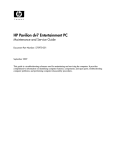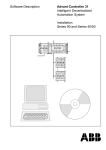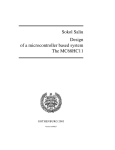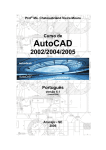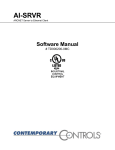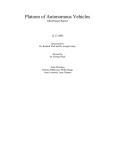Download User Manual - Contemporary Controls
Transcript
ARC-EVS ARCNET Evaluation System User Manual # TD020200-0MA Trademarks Contemporary Controls and ARC Control are registered trademarks of Contemporary Control Systems, Inc. ARCNET is a registered trademark of Datapoint Corporation. Other product names may be trademarks or registered trademarks of their respective companies. Copyright © Copyright 2002, by Contemporary Control Systems, Inc. All rights reserved. No part of this publication may be reproduced, transmitted, transcribed, stored in a retrieval system, or translated into any language or computer language, in any form or by any means, electronic, mechanical, magnetic, optical, chemical, manual, or otherwise, without the prior written permission of: Contemporary Control Systems, Inc. 2431 Curtiss Street Downers Grove, Illinois 60515 USA Tel: Fax: E-mail: WWW: +1-630-963-7070 +1-630-963-0109 [email protected] http://www.ccontrols.com Contemporary Controls Ltd Barclays Venture Centre University of Warwick Science Park Sir William Lyons Road Coventry CV4 7EZ UK Tel: Fax: E-mail: WWW: +44 (0)24 7641 3786 +44 (0)24 7641 3923 [email protected] http://www.ccontrols.eu Tel: Fax: E-mail: WWW: +86-21-62551335 +86-21-62552925 [email protected] http://www.ccontrols.com.cn Contemporary Controls Shanghai Representative Office Room 1012, Zhongchuang Building 819 Nanjing Road (W.) Shanghai 200041, China Disclaimer Contemporary Control Systems, Inc. reserves the right to make changes in the specifications of the product described within this manual at any time without notice and without obligation of Contemporary Control Systems, Inc. to notify any person of such revision or change. Warning — This is a Class A product as defined in EN55022. In a domestic environment this product may cause radio interference in which case the user may be required to take adequate measures. Contemporary Controls TD020200-0MA i Table of Contents 1 Introduction ......................................................................................................... 1 1.1 Description...................................................................................................................................................1 1.2 Kit Features..................................................................................................................................................2 1.3 ARCNET Evaluation Board Specifications ..................................................................................................3 1.4 PCI22-485X Specifications ..........................................................................................................................4 1.5 Fieldbus Connectors ....................................................................................................................................5 2 ARC-EVB Description ......................................................................................... 6 3 PCI22-485X NIM .................................................................................................. 8 3.1 Description...................................................................................................................................................8 3.2 Hardware Installation..................................................................................................................................8 3.3 Software Installation ....................................................................................................................................8 3.4 Indicator Lights............................................................................................................................................9 3.5 Node ID Switch ............................................................................................................................................9 3.6 Fieldbus Connection ....................................................................................................................................9 4 Source Code ...................................................................................................... 10 5 Modbus-over-ARCNET Setup........................................................................... 11 6 Modbus-over-ARCNET Operation .................................................................... 14 7 Firmware Modification ...................................................................................... 15 8 Keil Compiler/Debugger.................................................................................... 18 9 Service................................................................................................................ 20 9.1 Warranty ....................................................................................................................................................20 9.2 Technical Support ......................................................................................................................................20 9.3 Warranty Repair ........................................................................................................................................21 9.4 Non-Warranty Repair.................................................................................................................................21 9.5 Returning Products for Repair...................................................................................................................21 10 Appendix ............................................................................................................ 22 10.1 Modbus Message Format...........................................................................................................................22 10.2 ARC-EVB Component Layout ....................................................................................................................23 10.3 ARC-EVB Schematic Diagram...................................................................................................................24 Contemporary Controls TD020200-0MA ii Figures Figure 1 — ARC-EVS Components ........................................................................... 1 Figure 2 — Evaluation Board Block Diagram........................................................... 6 Figure 3 — PCI22-485X Indicator Lights and Node ID Switch................................. 9 Figure 4 — ARC-EVB Control Panel — Inactive..................................................... 12 Figure 5 — Application Settings.............................................................................. 12 Figure 6 — ARC-EVB Control Panel — Active ....................................................... 13 Figure 7 — LED Status ............................................................................................. 14 Figure 8 — LED Control ........................................................................................... 14 Figure 9 — Atmel Flip Initial Screen........................................................................ 15 Figure 10 — Device-Specific Panel before Reading the T89C51RB2 ..................... 16 Figure 11 — RS232 Options....................................................................................... 16 Figure 12 — Device-Specific Panel after Reading the T89C51RB2 ........................ 17 Figure 13 — Evaluation Board Layout ...................................................................... 23 Tables Table 1 — Connectors .................................................................................................. 7 Table 2 — Switches....................................................................................................... 7 Table 3 — Test Points ................................................................................................... 7 Table 4 — Data Rate (J8) .............................................................................................. 7 Contemporary Controls TD020200-0MA iii 1 Introduction 1.1 Description The ARCNET Evaluation System (ARC-EVS) is a very useful tool for exploring embedded ARCNET. The system contains: • one ARCNET Evaluation Board (ARC-EVB) • one PCI22-485X ARCNET network interface module (NIM) • one wall-mount power supply • one null-modem cable • one modular cable • one RJ-11 modular cable terminator • one RJ-45 modular cable terminator • one CD-ROM Figure 1 —ARC-EVS Components The ARC-EVB contains a microcontroller that allows users to upload their firmware into FLASH and execute it. It also works with the Keil compiler, which allows users to debug their ARCNET code on the board. The CPU is provided with external RAM to allow users to load up to 30 KB of firmware. The PCI22-485X is a PCI-based COM20022 ARCNET card. When the card is installed in a computer and connected to the ARC-EVB via the provided modular cable, a complete ARCNET network is created. Contemporary Controls TD000800-0MA 1 1.2 Kit Features • ARCNET compliant (ANSI/ATA 878.1) • Industrial temperature range (–40ºC to +85ºC) • Employs standard TTL signal levels • Dual RJ-11 jacks for EIA-485X ARCNET • Dual D-Sub 9 plugs for serial communication • Prototyping area with dual resettable fuses for Vcc • Linear power supply • One 8-pole DIP switch for Node ID • One 8-pole DIP switch for data input • 8 LEDs for input indication • 8 LEDs for output indication • LED for power indication Contemporary Controls TD020200-0MA 2 1.3 ARCNET Evaluation Board Specifications Electrical Power Requirements: Power Consumption: 1.8 W, maximum (with all LEDs lit) Voltage: 9–24 VDC Current: commensurate with applied voltage Environmental Operating Temperature: Storage Temperature: 0ºC to+60ºC –40ºC to+85ºC Data Rates 10 Mbps, 5 Mbps, 2.5 Mbps, 1.25 Mbps Dimensions 7" x 4" (178 mm x 102 mm) Functional Digital Signals: Number Type Input or Output: 8 TTL, 5 V Input Signal Voltage: 0–5 V Maximum Output Low: 450 mV, 1.6 mA Minimum Output High: 4.5 V, 10 µA Serial Port: TTL, 5 V ARCNET Compliance ANSI/ATA 878.1 LED Indicators Function Number Color Power 1 Green CPU Access 1 Yellow Fieldbus Data Received 1 Green Input Signals 8 Red Output Signals 8 Red Contemporary Controls TD020200-0MA 3 1.4 PCI22-485X Specifications Environmental Operating Temperature: Storage Temperature: 0ºC to+60ºC –40ºC to+85ºC Data Rates 10 Mbps, 5 Mbps, 2.5 Mbps, 1.25 Mbps Dimensions 4.20" x 5.5" (107 mm x 140 mm) I/O Mapping Requires 16 bytes of I/O space for COM20022 controller Interrupt Lines Supports PCI INTA Compatibility Fully compatible with all of Contemporary Controls ARCNET products and PCI bus computers. Regulatory Compliance CE Mark FCC Part 15 Class A Power Requirements Voltage: +5V Current: 400mA LED Indicators Function Number Color Host CPU Access 1 Yellow Fieldbus Data Transmitted 1 Green Contemporary Controls TD020200-0MA 4 1.5 Fieldbus Connectors Two cabling methods are provided for the fieldbus and differ by their connector type. Identical open-wire, 3-terminal connectors are available on both the ARC-EVB and the NIM: Open-Wire Connector Pin Assignments Pin Usage 1 Signal 2 Signal 3 Shield The ARC-EVB modular connector is of the RJ-11 type: RJ-11 Modular Connector Pin Assignments Pin Usage 1 Not Installed 2 Not Used 3 Signal 4 Signal 5 Not Used 6 Not Installed The NIM modular connector is of the RJ-45 type: RJ-45 Modular Connector Pin Assignments Pin Usage 1 Not Used 2 Not Used 3 Not Used 4 Signal 5 Signal 6 Not Used 7 Not Used 8 Not Used Contemporary Controls TD020200-0MA 5 2 ARC-EVB Description The core of the ARC-EVB is an Atmel T89C51 CPU which contains 16 KB of FLASH memory to hold the provided test application (Modbus-over-ARCNET)—or the user’s firmware. The FLASH memory can also hold the Keil monitor, allowing it to work with the Keil compiler/debugger. The ARC-EVB also contains an SMSC COM20022 ARCNET controller (backward compatible with the COM20020) which can support data rates from 156 kbps to 10 Mbps using a 20 MHz crystal. This chip offers enhanced features over earlier generation chips. New features include command chaining, sequential access to internal RAM, duplicate Node ID detection and variable data rates up to 10 Mbps. An 8-bit DIP switch (S1) is provided as the input device and 8 associated LEDs report the state of each input. An additional 8 LEDs indicate the states of the output signals. LED 7 in each array is the MSB. Another 8-bit DIP switch (S2) is used for setting the ARCNET Node ID. Switch 8 is the MSB. The data rate is set by jumpers at jumper block J8. The ARC-EVB uses an HYC4000 transformer-coupled ARCNET transceiver. This provides balanced EIA-485 signaling so that either a straight-through or a crossover cable can be used. ARCNET fieldbus connections are provided by either a 3terminal open-wire connector or an RJ-11 jack for standard twisted-pair cable. An extra RJ11 jack is provided for installing the modular terminator provided in the ARC-EVS. The extra jack can also be used for daisychaining a twisted-pair bus if the ARC-EVB is configured with more than one ARCNET adapter. Figure 2 — Evaluation Board Block Diagram Contemporary Controls TD020200-0MA 6 J1 2-pin header Boot ROM (for FLASH reprogramming) Leave off in normal operation J2 D-SUB 9 CPU UART Firmware upload and debug J3 D-SUB 9 Extra serial port Customer SPI development J4 RJ-11 ARCNET RJ-11 port Connect to PCI22-485X J5 RJ-11 ARCNET RJ-11 port Connect terminator here J6 Open 3-wire ARCNET 3 wire port Extra ARCNET port J7 30-pin header Prototyping header J8 6-pin header ARCNET data rate Set to desired rate (Table 4 — Data Rate (J8)) J9 Power input connector Using provided power supply Table 1 — Connectors Type Usage Comment S1 8-pin DIP Data Input Set to desired data value S2 8-pin DIP ARCNET Node ID Set to ARC-EVB ARCNET node ID Table 2 — Switches Usage DR0 DR1 DR2 Data Rate TP1 VCC — — — 2.5 Mbps TP2 GND X — — 1.25 Mbps TP3 Pulse1 ARCNET signal — X — 625 * kbps TP4 RXIN received ARCNET X X — 312.5 * kbps TP5 TXEN transmit enable — — X 156.25 * kbps TP6 EIA-485 output (Φ B) X — X 5 Mbps TP7 EIA-485 output (Φ A) — X X 10 Mbps X X X Table 3 — Test Points N/A ( X = jumper installed ) Table 4 — Data Rate (J8) * These rates are not supported by the ARC-EVB transceiver, but are available if the user wishes to replace the ARC-EVB transceiver with a custom transceiver. Contemporary Controls TD020200-0MA 7 3 PCI22-485X NIM 3.1 Description The PCI22-485X is one of a family of Contemporary Controls network interface modules (NIMs), each serving to link a PCI bus compatible computer with the ARCNET local area network (LAN). Each model within the family is identified by a model number ending in a 3- or 4-character suffix. This suffix specifies a transceiver type which matches a particular type of cable. Because the capabilities of each transceiver differ, different models cannot occupy the same LAN segment. The PCI22-485X supports data rates from 1.25 Mbps to 10 Mbps and operates in a Windows environment with one of our null stack drivers. The driver directory on the CD-ROM provides a selection of null stack drivers from which to choose. This NIM incorporates the same ARCNET controller chip as used on the ARC-EVB. Bus contention problems are minimized since the interrupt level and I/O base address are assigned through Plug and Play. There is no requirement for wait-state arbitration. Two LEDs monitor network operation and bus access to the module. An external DIP switch allows node addresses to be easily reassigned without removing the module. 3.2 Hardware Installation The NIM can be installed in any PCI bus compatible computer bus. With power detached from the computer, remove the computer cover to expose the motherboard and expansion slots (connectors). Care should be taken when installing the card; both it and the exposed motherboard are sensitive to electrostatic discharge. To prevent inadvertent damage, touch the metal case of the internal power supply to discharge yourself then remove the card from its protective ESD package. Remove the backplate of the computer adjacent to the desired slot (connector). Then insert the card into this slot by applying an even downward pressure until it firmly seats in the connector. The card’s backplate can be fastened to the computer with the small screw used to attach the original backplate. Hardware installation is completed by replacing the computer’s cover. 3.3 Software Installation Unlike ISA bus computers, PCI bus computers usually have their resources assigned by the operating system. The PCI22-485X NIM requires one interrupt line and a 16 byte I/O range for the COM20022 ARCNET controller. Once the NIM is inserted and power applied to the computer, Windows will recognize the card and ask the user for the driver location. Point to the folder appropriate to the version of Windows being used. After loading is complete the driver will be active. The driver can be disabled from the Device Manager. Contemporary Controls TD020200-0MA 8 3.4 Indicator Lights There are two LEDs located at the NIM’s backplate. The green LED indicates that the card is transmitting ARCNET traffic to the network. The yellow LED indicates that the card is being accessed from the host computer via its I/O address. Figure 3 — PCI22-485X Indicator Lights and Node ID Switch 3.5 Node ID Switch Although not always needed, this NIM has a separate input port that reads an 8-bit DIP switch (SW1) located at the backplate. This switch is meant to serve as a Node ID switch, although it can serve as a general purpose switch if desired. The switch has no connection to the COM20022 controller chip. The most significant bit (MSB) is switch position 8, and the least significant bit (LSB) is switch position 1. A switch in the open position (off position or away from the printed circuit board) introduces a logic “1.” In the example below, the switch is set to hexadecimal address AF. 3.6 Fieldbus Connection The PCI22-485X NIM supports AC-coupled communication via its daughter board which has a fixed-bias network isolated by a pulse transformer. Unlike DC-coupled devices, bias adjustment is unneeded and wiring polarity is unimportant. Dual RJ-45 jacks and one three-position screw terminal connector are the options for attaching the field bus wiring. For convenience, a modular cable is provided for connecting the NIM to the ARC-EVB. Each end of the fieldbus wiring must have a proper value of termination resistance. The NIM provides two options to achieve proper termination: Onboard Termination: Install the E1 jumper on the daughter board to apply an onboard resistance across the twisted-pair. If the jumper is removed, no termination is applied. External Termination: If you wish to enable or disable termination without removing the NIM from the host computer, external termination can be used. In this case, remove jumper E1 and insert either the provided RJ-45 modular terminator in the unused RJ-45 jack or a 120 ohm 1/4 watt resistor across pins 1 and 2 on the screw terminal connector. NOTE: Terminating with a value less than 100 ohms will excessively load the EIA-485 transceivers—so you must only use one method of termination at a time. If more ARCNET devices are attached to the NIM and the ARC-EVB in a bus topology, only apply termination to the devices located at the ends of the bus. Contemporary Controls TD020200-0MA 9 4 Source Code The ARC-EVB is provided with Modbus-over-ARCNET example code for both server and client. When the server example code is executed on the ARC-EVB, it can receive one byte of output data and can transmit one byte of input data when polled by the Modbus client. The 8 LEDs on the ARC-EVB are used to indicate the received output data. The 8-bit DIP switch (S1) is used to provide ARC-EVB input data. The client software executes on a PC in which our PCI22-485X has been installed and requires the version of our Null Stack driver appropriate to the version of Windows being used. The Modbus client will continually request current Modbus data from the Modbus server (ARC-EVB) and will also update server output data when modified by the user. The ARCNET Control Panel is illustrated in Figure 4. The server application causes the current ARC-EVB input data to be displayed in the LED Status section of the panel and can change the ARC-EVB output data in the LED control section of the panel. The 8 output LEDs on the ARCEVB are used to display its output state. Also included is a Keil monitor HEX file that (when copied to the ARC-EVB) allows the ARCEVB to communicate with the Keil debugger. The HEX file for the Modbus-over-ARCNET server is also provided. This allows the user to switch between debugging with the Keil compiler and executing the Modbus-over-ARCNET server. Updated versions of Modbus-over-ARCNET client and server can be downloaded from www.ccontrols.com. Contemporary Controls TD020200-0MA 10 5 Modbus-over-ARCNET Setup Confirm that the PCI22-485X NIM has been properly installed in the host computer (as per Sections 3.2 and 3.3) and that the ARC-EVB EEPROM contains the Modbus hex file. The ARC-EVB has been factory programmed with the Modbus firmware—so loading this firmware will only be needed if it has been erased. (See Section 7 for firmware modification). PCI22-485X NIM Setup: • Set the NIM’s Node ID switch to the desired value (1–255, decimal) as per Section 3.5. Optionally, the Node ID can be set via the Windows Application below. • Make sure the NIM has proper cable termination applied as per Section 3.6. ARC-EVB Setup: NOTE: The ARC-EVB will initialize with Data Rate and Node ID values existing during power up. Changes to these parameters will have no effect unless power is recycled. • Set the Data Rate jumpers (J8) to the desired data rate as per Table 4 — Data Rate (J8). • Set the Node ID DIP switch (S2) to a Node ID that differs from that set on the NIM. • Install jumper JP1 to invoke onboard fieldbus termination. Optionally, the provided RJ-11 modular terminator may be inserted in the unused RJ-11 jack. • Apply power. Fieldbus Setup: • Connect the NIM to the ARC-EVB with the provided modular cable. Optionally, any CAT-5 twisted-pair cable may be attached between the open-wire connectors. Contemporary Controls TD020200-0MA 11 Windows Application Setup: • Launching the application will display the Control Panel in Figure 4. Until the Settings Panel options have been entered, the Control Panel features will remain inactive. Figure 4 — ARC-EVB Control Panel — Inactive • Selecting the Settings menu item will display the Settings Panel in Figure 5. Figure 5 — Application Settings • In the Node ID box enter the ARCNET Node ID to be associated with the NIM (and its host computer). A zero value causes the Node ID to be read from the NIM’s DIP switch. • The Board Number field specifies how many ARCNET NIMS are installed in the host computer. The default value of “1” rarely needs changing. If more Contemporary Controls PCI-based NIMS are installed, enter that number. • In the Data Rate box select the data rate which matches that set on the ARC-EVB. Contemporary Controls TD020200-0MA 12 After completing the settings, the Control Panel will appear as in Figure 6. Three fields are “dimmed” because they are read-only — Read Status, Control Status and Number of Recons. Figure 6 — ARC-EVB Control Panel — Active • Enter a hex value for the Destination Node ID which agrees with the DIP switch value set on the ARC-EVB. This value must differ from the ID value set for the NIM. • The application is now ready for operation. Contemporary Controls TD020200-0MA 13 6 Modbus-over-ARCNET Operation When the ARC-EVB and the Windows application have achieved proper communications, the Control Panel will affect operation as follows. Reading LED Status from the ARC-EVB Clicking the Start Button, will initiate the transmission of Modbus Function 3H Query Messages (see Section 10.1). The application will continually read information from the Input DIP switch (S1) on the ARC-EVB. Each time the read action is successful, the message “RX OK!” will appear in the Read Status field. As long as the ARCEVB is working, each change to the Input DIP switch will instantly appear in the LED Status area of the Control Panel. Turning a switch “On” lights its associated LED on the ARC-EVB and causes its associated LED icon in the Control Panel to glow red. In the example shown in Figure 7, switches 4-7 have been turned on. Figure 7 — LED Status While the Start Button is dim, changing the value in the Destination ID field will have no effect on the read action. Clicking the Stop Button concludes the read action, but the last data read continues to display. The next time the Start Button is clicked, the read function will use the current value in the Destination ID field — but the read action will not be successful unless this new value matches the Node ID value with which the ARC-EVB was initialized. Controlling LEDs on the ARC-EVB Changes in LED Control will affect the Output LEDs on the ARC-EVB. LED Control has 8 checkboxes. Each time a checkbox is clicked, two things are determined — the Destination ID and the status of all 8 checkboxes. The checkbox data are transmitted via a Modbus Function 10H Query Message (see Section 10.1) to activate the corresponding LEDs on the ARC-EVB. But the transmission will fail unless the Destination ID matches the Node ID with which the ARC-EVB was initialized. Figure 8 — LED Control Figure 8 shows a query to activate LEDs 0 and 2 has been successfully sent to Node ID 1. The Control Status message “RX OK!” only means that a properly formatted query and response were exchanged. It does not confirm that the correct data arrived at the destination. Number of Recons Network reconfigurations are counted in this field. The count can be reset to zero only by restarting the application. Contemporary Controls TD020200-0MA 14 7 Firmware Modification The Atmel Flip application included on the CD-ROM is used to modify the ARC-EVB firmware. The application includes detailed online help, but a procedural overview is presented below. Procedure: 1. Connect the ARC-EVB to a PC via the provided null-modem cable. 2. On the ARC-EVB, install the J1 jumper to enable firmware modification. 3. Apply power to the ARC-EVB. 4. Launch the Atmel Flip application. Figure 9 — Atmel Flip Initial Screen 5. The screen of Figure 9 appears with a lower left corner message prompting you to … 6. Open the Device menu and select a device. Choose the T89C51RB2 and click OK. Contemporary Controls TD020200-0MA 15 7. The screen changes to display the device-specific panel with appropriate fields for the T89C51RB2. As shown in Figure 10, these fields will remain read-only and the panel will remain “dimmed” until you specify the communication settings. Figure 10 — Device-Specific Panel before Reading the T89C51RB2 8. Open the Settings > Communications menu option and choose RS232. The RS232 options depicted in Figure 11 will appear. Figure 11 — RS232 Options 9. From the RS232 options, choose the Port appropriate to your computer and set the Baud value to 19200. Then click Connect. Contemporary Controls TD020200-0MA 16 10. If the ARC-EVB is working and the signal path between it and the PC is proper, the device-specific panel will be updated with data read from the T89C51RB2 as shown in the example of Figure 12. (If communication between the Flip application and the ARC-EVB is improper, a Time Out Error will occur — check the ARC-EVB and the fieldbus cable.) Leave the upper portion of this panel alone, but make sure (as shown in Figure 12) that these adjustments are set in the lower portions of the panel: • De-select X2 Mode • Set Device SBV (Software Boot Vector) to FC • Set the Device SSB (Software Security Byte) to FF Figure 12 — Device-Specific Panel after Reading the T89C51RB2 11. To copy a new program to the ARC-EVB … • • • Select the menu item File > Load HEX … and open the desired file. The filename and size will be verified in the lower center area of the Flip window. Under the Operations Flow panel on the left of the Flip window, check these boxes — Erase, Blank Check, Program and Verify Click Run. The checked Operations Flow options should appear green, if successful. When finished, close the Flip application, remove power from the ARC-EVB and remove jumper J1. The next time you power up the board, it should execute the new firmware. Contemporary Controls TD020200-0MA 17 8 Keil Compiler/Debugger The ARC-EVB has been designed to work with the Keil Compiler/Debugger. An evaluation version of the Keil Compiler/Debugger is included on the provided CD-ROM. This evaluation version is limited as follows: • The compiler, assembler, linker, and debugger are limited to 2 Kbytes of object code— although source code may be of any size. Programs that generate more than 2 Kbytes of object code will not compile, assemble, or link. • The generated startup code includes LJMPs and will not work in single-chip devices which are limited to less than 2 Kbytes of program space. • The debugger supports files that are 2 Kbytes or smaller. • Programs begin at offset 0x0800 and cannot be programmed into single-chip devices. • No hardware support is available for multiple DPTR registers. • No support is available for user libraries or floating-point arithmetic. The following components are present in the full version, but not in the Keil evaluation software: • Code-Banking Linker/Locator • Library Manager • RTX-51 Tiny Real-Time Operating System To obtain a full-featured version of the Keil software, use the contact information below: Keil Software, Inc. 1501 10th Street, Suite 110 Plano, TX 75074 USA Keil Elektronik GmbH Bretonischer Ring 15 D-85630 Grasbrunn Germany Toll Free: 800-348-8051 Phone: 972-312-1107 Phone: (49) (089) 45 60 40 0 Fax: 972-312-1159 Fax: (49) (089) 46 81 62 Sales: [email protected] Sales: [email protected] Support: [email protected] Support: [email protected] Contemporary Controls TD020200-0MA 18 The Modbus-over-ARCNET server can be debugged on the ARC-EVB using the Keil Debugger. Detailed built-in help screens are included with the Keil Compiler/Debugger, but a helpful general overview of using the Keil tools is presented below: • Set the PC serial port to a baud rate of 19200. • Copy the entire Modbus-over-ARCNET server folder to your computer. * • Use Atmel Flip to copy the Keil monitor from the MON51 directory to the ARC-EVB. • Remove the J1 jumper from the ARC-EVB. • Recycle power to the ARC-EVB. • Start the Keil compiler. • Using the Project > Open Project menu option, open arc_eval.uv2. • In the Select Target box, choose Debug Image. • Use the Project > Rebuild all target files option to compile, link and build the project. • With the Debug > Start/Stop Debug Session option, load the target to the ARC-EVB. • When the download is completed, enter $=0x8000 in the Command Line Window to set the program counter to 0x8000. • Use the debugging options under the Debug menu to single step, set breakpoints or run the application. When the debugging is finished, terminate the debug activity with the menu option Debug > Start/Stop Debug Session. The final firmware to be written to the board is in target Flash Image. Use the Project > Rebuild all target files option to rebuild the flash image and generate a hex file called arc_flash.hex. Use the Atmel Flip application to copy the hex file to the ARC-EVB. * NOTE: When copying files from CD-ROM to hard disk, they will be created as read-only files, but some of these files need to be updated. For such files to be used, this read-only property must be cleared. Contemporary Controls TD020200-0MA 19 9 Service 9.1 Warranty Contemporary Controls (CC) warrants its product to the original purchaser for one year from the product’s shipping date. If a CC product fails to operate in compliance with its specification during this period, CC will, at its option, repair or replace the product at no charge. The customer is, however, responsible for shipping the product; CC assumes no responsibility for the product until it is received. This warranty does not cover repair of products that have been damaged by abuse, accident, disaster, misuse, or incorrect installation. CC’s limited warranty covers products only as delivered. User modification may void the warranty if the product is damaged during installation of the modifications, in which case this warranty does not cover repair or replacement. This warranty in no way warrants suitability of the product for any specific application. IN NO EVENT WILL CC BE LIABLE FOR ANY DAMAGES INCLUDING LOST PROFITS, LOST SAVINGS, OR OTHER INCIDENTAL OR CONSEQUENTIAL DAMAGES ARISING OUT OF THE USE OR INABILITY TO USE THE PRODUCT EVEN IF CC HAS BEEN ADVISED OF THE POSSIBILITY OF SUCH DAMAGES, OR FOR ANY CLAIM BY ANY PARTY OTHER THAN THE PURCHASER. THE ABOVE WARRANTY IS IN LIEU OF ANY AND ALL OTHER WARRANTIES, EXPRESSED OR IMPLIED OR STATUTORY, INCLUDING THE WARRANTIES OF MERCHANTABILITY, FITNESS FOR PARTICULAR PURPOSE OR USE, TITLE AND NONINFRINGEMENT. Repair or replacement as provided above shall be the purchaser's sole and exclusive remedy and CC's exclusive liability for any breach of warranty. 9.2 Technical Support Technical support is available each weekday (except holidays) during the office hours listed below. Outside these hours, voice-mail messages can be left in our mailbox after contacting the main phone number. Requests can also be submitted by fax or by e-mail to the numbers listed below, but please leave a detailed description of the problem. We will contact you the next business day by the method you request. If the problem cannot be resolved by technical support, the customer will be given an RMA number so that the product may be returned to CC for repair. Contemporary Controls (USA) Office Hours Contemporary Controls Ltd (UK) 8 a.m. – 5 p.m. Central time 8 a.m. – 5 p.m. UK time Voice +1-630-963-7070 +44 (0)24 7641 3786 Fax +1-630-963-0109 +44 (0)24 7641 3923 [email protected] [email protected] www.ccontrols.com www.ccontrols.co.uk Email Web Site Contemporary Controls TD020200-0MA 20 9.3 Warranty Repair Products under warranty that were not subjected to misuse or abuse will be repaired at no charge to the customer. The customer, however, pays for shipping the product back to CC while CC pays for the return shipment to the customer. CC normally ships ground. International shipments may take longer. If the product has been determined to be misused or abused, CC will provide the customer with a quotation for repair. No work will be done without customer approval. 9.4 Non-Warranty Repair CC provides a repair service for all its products. Repair charges are based upon a fixed fee basis depending upon the complexity of the product. Therefore, Customer Service can provide a quotation on the repair cost at the time a Returned Material Authorization (RMA) is requested. Customers pay the cost of shipping the defective product to CC and will be invoiced for the return shipment to their facility. No repair will be performed without customer approval. If a product is determined to be unrepairable, the customer will be asked if the product can be replaced with a refurbished product (assuming one is available). Under no circumstances will CC replace a defective product without customer approval. Allow ten working days for repairs. 9.5 Returning Products for Repair To schedule service for a product, please call CC Customer Service support directly at +1-630963-7070 (U.S.) or +44 (0)24 7641 3786 (U.K.). Have the product model and serial number available, along with a description of the problem. A Customer Service representative will record the appropriate information and issue, via fax, an RMA number—a code number by which we track the product while it is being processed. Once you have received the RMA number, follow the instructions of the Customer Service support representative and return the product to us, freight prepaid, with the RMA number clearly marked on the exterior of the package. If possible, reuse the original shipping containers and packaging. In any event, be sure you follow good ESD-control practices when handling the product, and ensure that antistatic bags and packing materials with adequate padding and shock-absorbing properties are used. CC is not responsible for any damage incurred from improper packaging. Shipments should be insured for your protection. Ship the product, freight prepaid, to the location from which it was purchased: Contemporary Control Systems, Inc. 2431 Curtiss Street Downers Grove, IL 60515 U.S.A. Contemporary Controls Ltd Barclays Venture Centre University of Warwick Science Park Sir William Lyons Rd. Coventry CV4 7EZ U.K. Contemporary Controls TD020200-0MA 21 10 Appendix 10.1 Modbus Message Format The Modbus protocol uses serial transmission. One Modbus transaction consists of a Query message and a Response message. A Modbus-over-ARCNET message consists of: • ARCNET Header • Modbus Message The ARC-EVS supports the use of two Modbus functions: • Function Read Holding Registers (3H) — which reads the status of the input LEDs on the AEB • Function Preset Multiple Registers (10H) — which writes a value to the output LEDs on the AEB The formatting of these two functions is illustrated below: Format of the Read Holding Registers Function (3H) Query Message System Code Split Flag Sequence Sequence Number Number LSB MSB Slave Address Function Number (3H) Starting Address MSB Starting Address LSB Slave Address Function Number (3H) Byte Count Data MSB Number of Number of Points Points MSB LSB Response Message System Code Split Flag Sequence Sequence Number Number LSB MSB ARCNET Header Data LSB Modbus Message Input LED Status Occupies LSB Data to Output LED Occupies LSB Format of the Preset Multiple Registers Function (10H) Query Message System Code Split Flag Sequence Sequence Function Starting Starting Register Register Slave Byte Number Number Number Address Address Number Number Address Count (10H) LSB MSB MSB LSB MSB LSB Data MSB Response Message System Code Split Flag Sequence Sequence Number Number LSB MSB Function Number (10H) Slave Address ARCNET Header Byte Count Data MSB Modbus Message Contemporary Controls TD020200-0MA 22 Data LSB Data LSB 10.2 ARC-EVB Component Layout Figure 13 — Evaluation Board Layout Contemporary Controls TD020200-0MA 23 10.3 1 2 Schematic Diagram — Sheet 1 3 4 6 5 D D CPU, Memory, Logic, & UART CPU.SCH AD[0..15] RD# WR# ALE CLOCK CS_ARC# INT_ARC# ARC_RES# CS_IO# CS_ARCID# CS_ARCDR# MOSI MISO SCK P1_0 P1_1 P1_2 P1_3 P1_4 C RESET# ARCNET Controller & Transceiver ARC.SCH AD[0..15] RD# WR# ALE CLOCK CS_ARC# INT_ARC# ARC_RES# Power Supply PWR.SCH AD[0..15] RD# WR# ALE CLOCK CS_ARC# INT_ARC# ARC_RES# CS_IO# CS_ARCID# CS_ARCDR# MOSI MISO SCK P1_0 P1_1 P1_2 P1_3 P1_4 C Digital I/O IO.SCH RESET# AD[0..15] RD# WR# CS_IO# CS_ARCID# CS_ARCDR# MOSI MISO SCK P1_0 P1_1 P1_2 P1_3 P1_4 B B RESET# CHASSIS MP1 MTGPAD MP2 MTGPAD MP3 MP4 MTGPAD MTGPAD Contemporary Control Systems, Inc. A Title Size Date: File: 1 2 3 4 5 B 2431 Curtiss Street Downers Grove, IL 60515 ARCNET Evaluation Board Revision B TD020200-0SA Number 23-Apr-2002 Sheet 1 Drawn By: of 6 RCW 6 A 10.3 1 2 3 R2 VCC VCC OE VCC D C17 .1uF 4 2 3 GND OUT CLOCK 20MHz GND VCC MISO SCK MOSI RxD TxD U2 1 2 3 4 C1 .1uF 2 3 4 5 6 7 8 9 MR VCC GND PFI 8 7 RES RES RESET RESET# INT_ARC# RESET# 5 PFO WR# RD# ADM708AR GND INT_UART# RESET2# CS_UART# WR# RD# 11 13 14 15 16 17 18 19 RESET 10 U20C RESET 9 R18 8 10 680 GND D21 GREEN VCC POWER OK CLOCK 21 P0.0/AD0 P0.1/AD1 P0.2/AD2 P0.3/AD3 P0.4/AD4 P0.5/AD5 P0.6/AD6 P0.7/AD7 P3.0/RxD P3.1/TxD P3.2/INT0# P3.3/INT1# P3.4/T0 P3.5/T1 P3.6/WR# P3.7/RD# P2.0/A8 P2.1/A9 P2.2/A10 P2.3/A11 P2.4/A12 P2.5/A13 P2.6/A14 P2.7/A15 XTAL2 ALE PSEN# EA# XTAL1 VCC GND 43 42 41 40 39 38 37 36 AD0 AD1 AD2 AD3 AD4 AD5 AD6 AD7 24 25 26 27 28 29 30 31 AD8 AD9 AD10 AD11 AD12 AD13 AD14 AD15 33 32 35 ALE PSEN# VCC ALE GND AD0 AD1 AD2 AD3 AD4 AD5 AD6 AD7 1 11 3 4 7 8 13 14 17 18 OC C VCC GND 1D 2D 3D 4D 5D 6D 7D 8D C20 .1uF 20 10 GND 2 5 6 9 12 15 16 19 1Q 2Q 3Q 4Q 5Q 6Q 7Q 8Q BA0 BA1 BA2 BA3 BA4 BA5 BA6 BA7 AD8 AD9 AD10 AD11 AD12 AD13 AD14 AD15 MM74HC373 AD[0..15] AD[0..15] ALE 20 19 18 17 16 15 14 13 3 2 31 1 12 4 11 7 10 GND 44 22 U5 A0 A1 A2 A3 A4 A5 A6 A7 A8 A9 A10 A11 A12 A13 A14 A15 A16 AD0 AD1 AD2 AD3 AD4 AD5 AD6 AD7 21 22 23 25 26 27 28 29 D0 D1 D2 D3 D4 D5 D6 D7 D VCC 8 VCC GND CE1 CE2 OE WE 24 C21 .1uF 30 6 32 5 CS_RAM# VCC MRD# WR# GND RAM/128K/TSOP32 VCC C22 .1uF AT89C51RC2 MM74HC32 VCC U4 P1.0/T2 P1.1/T2EX/SS P1.2/EC1 P1.3/CEX0 P1.4/CEX1 P1.5/CEX2/MISO P1.6/CEX3/SCK P1.7/CEX4/MOSI RESET 20 6 5 Socket U3 P1_0 P1_1 P1_2 P1_3 P1_4 MISO SCK MOSI CLOCK 4 MISO 10K R1 390 U1 1 Schematic Diagram — Sheet 2 GND C C Chip Select & Boot Logic LOGIC.Sch BOOT PROCESS: AD[0..15] PSEN# ALE CLOCK RESET Instal boot jumper to enable internal boot ROM on startup so you can program flash memory. PSEN# and ALE are sampled on falling edge of RESET to determine boot mode. These signals must be released prior to the 24th clock cycle after the falling edge of RESET. AD[0..15] PSEN# ALE CLOCK RESET U6A VCC CS_ARC# CS_IO# CS_ARCID# CS_ARCDR# VCC 1 RD# 2 U6B RESET# 4 RESET2# 5 GND 6 R3 2 ARC_RES# MM74HC08 GND 10K MRD# MM74HC08 C2 .1uF BOOT_ROM J1 1 3 CS_RAM# CS_RAM# CS_ARC# CS_IO# CS_ARCID# CS_ARCDR# PSEN# BOOT ROM VCC C4 .1uF 1 3 B C3 .1uF U8 MOSI MISO SCK CS_UART# INT_UART# VCC U7 1 C18 .1uF 2 OE VCC GND OUT 4 3 VCC 1 2 3 4 6 7 10 TxD DIN DOUT SCLK CS IRQ SHDN TX RX RTS CTS 15 14 13 11 GND 11 10 12 9 C1+ C1- IVCC IGND C2+ C2- V+ V- T1_IN T2_IN TTL R1_OUT R2_OUT T1_OUT T2_OUT RS232 R1_IN R2_IN C5 .1uF 16 15 2 6 V+ V- 1 6 2 7 3 8 4 9 5 GND C6 .1uF C7 .1uF 14 7 13 8 X1 IVCC X2 IGND MAX3100/QSOP16 10 J3 1 6 2 7 3 8 4 9 5 C8 .1uF 8 CPU UART DB9 MALE MAX232 GND Program can be loaded into RAM from 8000H to F3FFH. The PSEN# signal is only active above 32K. This will allow 29,696 bytes for program storage during debugging. RAM can be accessed as XDATA anywhere except between F400H to F7FFH. The internal boot ROM is located between F800H and FFFFH, so RAM will not be available in that region, either. 11 SPI UART 10 CHASSIS GND A Contemporary Control Systems, Inc. DB9 MALE Title Size Date: File: 1 2 3 4 B All I/O is memory mapped in a 1K memory region from F400H to F7FFH. RAM is mapped in all other addresses. 11 CHASSIS GND VCC 16 1.8432MHz 9 RxD 4 5 CHIP SELECT NOTES: J2 U9 5 B 2431 Curtiss Street Downers Grove, IL 60515 CPU, Memory, Logic, & UART Number Revision B TD020200-0SA 23-Apr-2002 Sheet 2 Drawn By: of 6 RCW 6 A 10.3 1 Schematic Diagram - Sheet 3 2 3 4 U6C AD15 U14 9 8 AD14 AD8 AD9 U11A 10 U11B 1 D MM74HC08 U6D AD13 3 6 12 A B C 4 2 6 4 5 5 11 AD12 1 2 3 MM74HC08 G1 G2A G2B MM74HC08 13 GND AD11 AD9 AD8 4 9 10 VCC HIGH: F400H - F7FFH C11 .1uF 8 HC14/SINGLE AD10 VCC C9 .1uF GND CS_RAM# Chip Select Addresses CS_RAM# CS_ARC# CS_IO# CS_ARCID# CS_ARCBR# GND AD[0..15] D GND MM74HC08 C10 .1uF C CS_ARC# CS_IO# CS_ARCID# CS_ARCDR# U11C U12 2 15 14 13 12 11 10 9 7 MM74HC138 VCC MM74HC08 Y0 Y1 Y2 Y3 Y4 Y5 Y6 Y7 AD[0..15] 0000H - F3FFH F400H - F4FFH F500H - F5FFH F600H - F6FFH F700H - F7FFH C BOOT_ROM Q0 Q1 Q2 Q3 Q4 Q5 Q6 B 3 4 7 8 13 14 17 18 1D 2D 3D 4D 5D 6D 7D 8D 2 5 6 9 12 15 16 19 1Q 2Q 3Q 4Q 5Q 6Q 7Q 8Q Q0 Q1 Q2 Q3 Q4 Q5 Q6 GND 6 PSEN# VCC 2 B U16B MM74HC126 C13 .1uF 3 U16A MM74HC126 MM74HC273 5 10 RESET CLR CLK 1 CLOCK 1 11 4 U15 VCC R19 10K VCC GND 9 8 ALE VCC GND U16C MM74HC126 C12 .1uF GND Contemporary Control Systems, Inc. Title A Size Date: File: 1 2 3 A 2431 Curtiss Street Downers Grove, IL 60515 Chip Select & Boot Logic Number Revision B TD020200-0SA 23-Apr-2002 Sheet 3 Drawn By: of 6 RCW 4 A 10.3 1 2 Schematic Diagram — Sheet 4 3 TP3 PULSE1 4 TP4 RXIN 6 5 TP5 TXEN TP6 RS485B TP7 RS485A D D CHASSIS J6 1 2 3 U18 8 CLOCK 7 U17 C GND ALE 44 45 46 37 39 36 WR# RD# CS_ARC# 42 26 VCC 33 35 38 40 34 31 INT_ARC# ARC_RES# AD0 AD1 AD2 D3 D4 D5 D6 D7 D8 D9 D10 D11 D12 D13 D14 D15 XTAL1 IOCS16 BUSTMG DREQ DACK TC REFEX INT RESET 3 2 VCC XTAL2 C32 10uF 22 C19 .1uF 6 PH_B 4 RX485AC_B C23 RXIN VCC GND Vref 1 TWISTED PAIR J4 R5 5.6K, 1/2W R6 5.6K, 1/2W 6 5 4 3 2 1 R7 5.6K, 1/2W S1 S2 RJ11 PULSE1 PULSE2 TXEN RXIN 24 J5 25 CHASSIS CHASSIS 6 5 4 3 2 1 29 JP1 2 28 1 TERMINATION R20 100 S1 S2 VCC VCC VCC VCC GND GND GND GND GND GND NC NC 8 20 32 43 VCC 6 11 18 23 30 41 C25 .1uF C26 .1uF GREEN U13 2 C40 .1uF C27 .1uF U19A 4 VCC HC14/SINGLE VCC R10 GND C15 .1uF C CHASSIS RJ11 VCC 150K 1 2 3 14 15 + C33 100pF A B CLR Cext Rext/Cext Q Q VCC GND 13 4 16 8 D1 R8 VCC 470 DATA VCC C16 .1uF MM74HC423A GND GND 19 27 GND YELLOW U11D 12 COM20022/TQFP48 U19B 11 13 U20A B C24 R4 5.6K, 1/2W HYC4000 GND A0/MUX A1 A2/ALE WR RD CS 21 TXEN 27pF, 1KV AD[0..15] 1 2 4 7 9 10 12 13 47 48 3 5 14 15 16 17 PH_A RX485AC_A 27pF, 1KV AD[0..15] AD0 AD1 AD2 AD3 AD4 AD5 AD6 AD7 PULSE_1 5 1 VCC MM74HC08 3 2 VCC VCC MM74HC32 U20B R11 150K C14 .1uF 4 + C34 .1uF 9 10 11 6 7 A B CLR Cext Rext/Cext Q Q 5 12 D2 R9 VCC 470 B ACCESS MM74HC423A GND 6 5 GND MM74HC32 Contemporary Control Systems, Inc. A Title Size ARCNET Controller & Transceiver Number Revision B B TD020200-0SA Date: 23-Apr-2002 File: S3_ARC.SCH 1 2 3 4 5 2431 Curtiss Street Downers Grove, IL 60515 Sheet 4 Drawn By: of 6 RCW 6 A 10.3 1 2 AD[0..15] Schematic Diagram — Sheet 5 3 4 D3 RESET# D U21A CS_IO# WR# Prototype Area Header Outputs AD[0..15] U23 1 11 1 3 2 AD0 AD1 AD2 AD3 AD4 AD5 AD6 AD7 MM74HC32 3 4 7 8 13 14 17 18 U21B 4 CLR CLK 1D 2D 3D 4D 5D 6D 7D 8D RED RP1 2 5 6 9 12 15 16 19 1Q 2Q 3Q 4Q 5Q 6Q 7Q 8Q OUT0 OUT1 OUT2 OUT3 OUT4 OUT5 OUT6 OUT7 1 2 3 4 5 6 7 8 16 15 14 13 12 11 10 9 D5 RED D6 D7 RED RED D8 D9 330 J7 INP7 INP5 INP3 INP1 OUT7 OUT5 OUT3 OUT1 XIN3 XIN1 RED D4 MOSI MISO SCK P1_4 RED RED D10 MM74HC273 F1 2 4 6 8 10 12 14 16 18 20 22 24 26 28 30 INP6 INP4 INP2 INP0 OUT6 OUT4 OUT2 OUT0 XIN2 XIN0 D P1_0 P1_1 P1_2 P1_3 GND PROTOTYPE HEADER RESETTABLE 5 GND U24 MM74HC32 AD0 AD1 AD2 AD3 AD4 AD5 AD6 AD7 C 19 18 17 16 15 14 13 12 1Q 2Q 3Q 4Q 5Q 6Q 7Q 8Q D11 1 11 OC C INP0 S1 2 3 4 5 6 7 8 9 1D 2D 3D 4D 5D 6D 7D 8D INP0 INP1 INP2 INP3 INP4 INP5 INP6 INP7 RED RP2 1 2 3 4 5 6 7 8 16 15 14 13 12 11 10 9 MM74HC573 Inputs VCC GND SW-DIP8 1 2 3 4 5 6 7 8 16 15 14 13 12 11 10 9 D13 RED D15 RED D17 330 RED U21C CS_ARCID# 1 3 5 7 9 11 13 15 17 19 21 23 25 27 29 VCC RED 6 RD# 6 5 9 D12 RP3 INP1 RED 16 15 14 13 12 11 10 9 INP2 D14 INP3 RED INP4 D16 INP5 RED INP6 1 2 3 4 5 6 7 8 C GND 10K D18 INP7 RED 8 10 U25 MM74HC32 AD0 AD1 AD2 AD3 AD4 AD5 AD6 AD7 B 19 18 17 16 15 14 13 12 1Q 2Q 3Q 4Q 5Q 6Q 7Q 8Q U21D CS_ARCDR# 1 11 OC C S2 2 3 4 5 6 7 8 9 1D 2D 3D 4D 5D 6D 7D 8D ARCID0 ARCID1 ARCID2 ARCID3 ARCID4 ARCID5 ARCID6 ARCID7 16 15 14 13 12 11 10 9 MM74HC573 12 RP4 1 2 3 4 5 6 7 8 ARCNET ID GND ARCID0 ARCID1 ARCID2 ARCID3 ARCID4 ARCID5 ARCID6 ARCID7 1 2 3 4 5 6 7 8 ARCNET NODE ID 16 15 14 13 12 11 10 9 VCC B 10K 11 13 U26 MM74HC32 19 18 17 16 15 14 13 12 AD0 AD1 AD2 AD3 AD4 AD5 AD6 AD7 1Q 2Q 3Q 4Q 5Q 6Q 7Q 8Q 1 11 OC C RP5 J8 2 3 4 5 6 7 8 9 1D 2D 3D 4D 5D 6D 7D 8D BAUD0 BAUD1 BAUD2 XIN0 XIN1 XIN2 XIN3 XIN4 1 3 5 2 4 6 DATARATE GND ARCNET Datarate VCC MM74HC573 F2 C42 .1uF C43 .1uF .1uF 1 2 3 4 5 6 7 8 16 15 14 13 12 11 10 9 VCC 10K VCC C41 .1uF BAUD0 BAUD1 BAUD2 XIN0 XIN1 XIN2 XIN3 XIN4 VCC C44 .1uF FUSE2 A TP2 GND VCC VCCP PROTOTYPE POWER TP1 VCC Contemporary Control Systems, Inc. GND C45 Title GND Size Date: File: 1 2 3 4 5 B Number 23-Apr-2002 2431 Curtiss Street Downers Grove, IL 60515 Digital I/O TD020200-0SA Revision Sheet 5 Drawn By: of B 6 RCW 6 A 10.3 1 2 Schematic Diagram — Sheet 6 3 4 6 5 D 3 4 D L1 R15 R13 PWR JACK 10 OHM, 1% C C28 .1uF R14 10 OHM, 1% 2 2.8K, 1% + C35 2200uF C29 .1uF C30 .1uF C31 .1uF 3 4 VSW VC GND D20 MBRS340T3 VCC 2 VIN 1 5 10 OHM, 1% 1N4004 CTX100-4 U27 R12 GND D19 1 2 3 R16 2.80K, 1% 1 FB LT1076 R17 2.21K, 1% 6 J9 + C36 220uF + C37 220uF + C38 220uF C + C39 220uF GND B 13 B U20D 12 12 11 11 13 GND U16D MM74HC126 GND MM74HC32 Spare Gates Contemporary Control Systems, Inc. A Title Size B Number Power Supply TD020200-0SA Date: 23-Apr-2002 File: PWR_SUPPLY.SCH 1 2 3 4 5 2431 Curtiss Street Downers Grove, IL 60515 Revision Sheet 6 Drawn By: of B 6 RCW 6 A

































